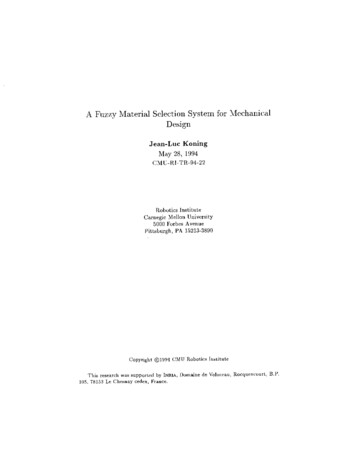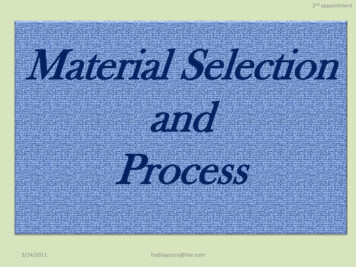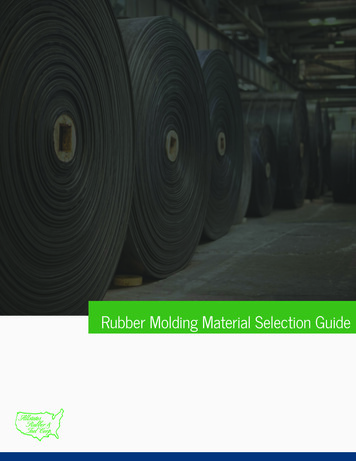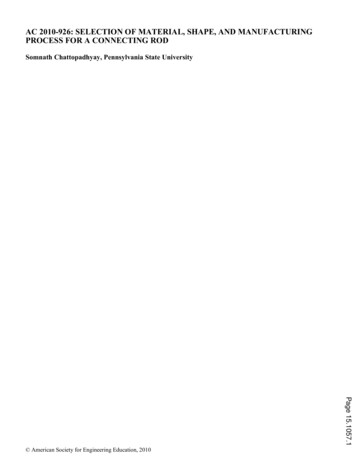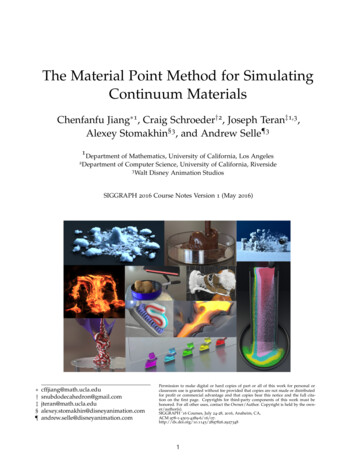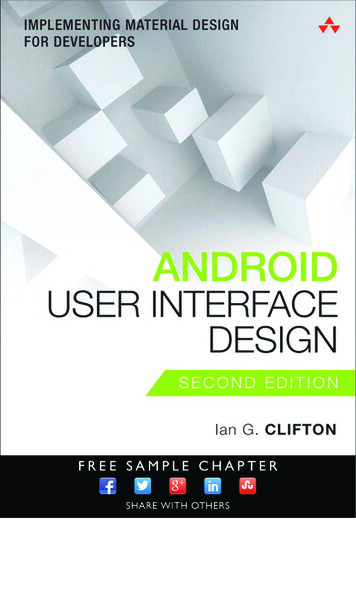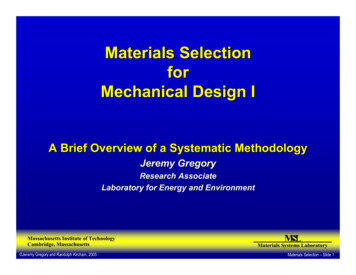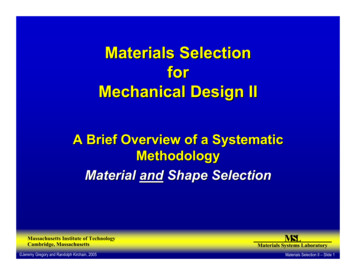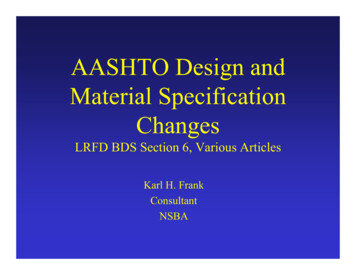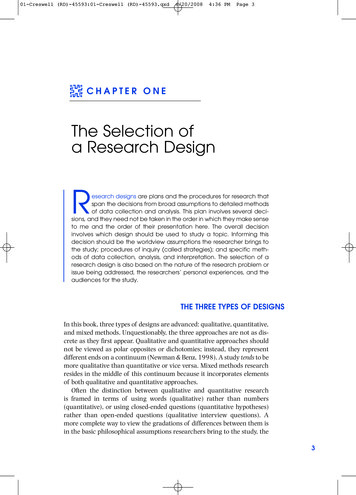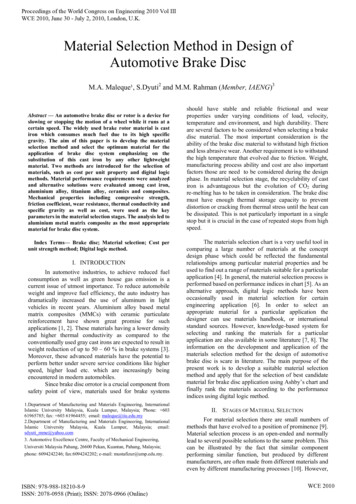
Transcription
Proceedings of the World Congress on Engineering 2010 Vol IIIWCE 2010, June 30 - July 2, 2010, London, U.K.Material Selection Method in Design ofAutomotive Brake DiscM.A. Maleque¹, S.Dyuti2 and M.M. Rahman (Member, IAENG)3 Abstract — An automotive brake disc or rotor is a device forslowing or stopping the motion of a wheel while it runs at acertain speed. The widely used brake rotor material is castiron which consumes much fuel due to its high specificgravity. The aim of this paper is to develop the materialselection method and select the optimum material for theapplication of brake disc system emphasizing on thesubstitution of this cast iron by any other lightweightmaterial. Two methods are introduced for the selection ofmaterials, such as cost per unit property and digital logicmethods. Material performance requirements were analyzedand alternative solutions were evaluated among cast iron,aluminium alloy, titanium alloy, ceramics and composites.Mechanical properties including compressive strength,friction coefficient, wear resistance, thermal conductivity andspecific gravity as well as cost, were used as the keyparameters in the material selection stages. The analysis led toaluminium metal matrix composite as the most appropriatematerial for brake disc system.should have stable and reliable frictional and wearproperties under varying conditions of load, velocity,temperature and environment, and high durability. Thereare several factors to be considered when selecting a brakedisc material. The most important consideration is theability of the brake disc material to withstand high frictionand less abrasive wear. Another requirement is to withstandthe high temperature that evolved due to friction. Weight,manufacturing process ability and cost are also importantfactors those are need to be considered during the designphase. In material selection stage, the recyclability of castiron is advantageous but the evolution of CO2 duringre-melting has to be taken in consideration. The brake discmust have enough thermal storage capacity to preventdistortion or cracking from thermal stress until the heat canbe dissipated. This is not particularly important in a singlestop but it is crucial in the case of repeated stops from highspeed.Index Terms— Brake disc; Material selection; Cost perunit strength method; Digital logic method.The materials selection chart is a very useful tool incomparing a large number of materials at the conceptdesign phase which could be reflected the fundamentalrelationships among particular material properties and beused to find out a range of materials suitable for a particularapplication [4]. In general, the material selection process isperformed based on performance indices in chart [5]. As analternative approach, digital logic methods have beenoccasionally used in material selection for certainengineering application [6]. In order to select anappropriate material for a particular application thedesigner can use materials handbook, or internationalstandard sources. However, knowledge-based system forselecting and ranking the materials for a particularapplication are also available in some literature [7, 8]. Theinformation on the development and application of thematerials selection method for the design of automotivebrake disc is scare in literature. The main purpose of thepresent work is to develop a suitable material selectionmethod and apply that for the selection of best candidatematerial for brake disc application using Ashby’s chart andfinally rank the materials according to the performanceindices using digital logic method.I. INTRODUCTIONIn automotive industries, to achieve reduced fuelconsumption as well as green house gas emission is acurrent issue of utmost importance. To reduce automobileweight and improve fuel efficiency, the auto industry hasdramatically increased the use of aluminum in lightvehicles in recent years. Aluminium alloy based metalmatrix composites (MMCs) with ceramic particulatereinforcement have shown great promise for suchapplications [1, 2]. These materials having a lower densityand higher thermal conductivity as compared to theconventionally used gray cast irons are expected to result inweight reduction of up to 50 – 60 % in brake systems [3].Moreover, these advanced materials have the potential toperform better under severe service conditions like higherspeed, higher load etc. which are increasingly beingencountered in modern automobiles.Since brake disc orrotor is a crucial component fromsafety point of view, materials used for brake systems1.Department of Manufacturing and Materials Engineering, InternationalIslamic University Malaysia, Kuala Lumpur, Malaysia; Phone: 60361965785; fax: 603 61964455; email: maleque@iiu.edu.my2.Department of Manufacturing and Materials Engineering, InternationalIslamic University Malaysia, Kuala Lumpur, Malaysia; email:sdyuti mme@yahoo.com3. Automotive Excellence Centre, Faculty of Mechanical Engineering,Universiti Malaysia Pahang, 26600 Pekan, Kuantan, Pahang, Malaysia;phone: 6094242246; fax:6094242202; e-mail: mustafizur@ump.edu.my.ISBN: 978-988-18210-8-9ISSN: 2078-0958 (Print); ISSN: 2078-0966 (Online)II. STAGES OF MATERIAL SELECTIONFor material selection there are small numbers ofmethods that have evolved to a position of prominence [9].Material selection process is an open-ended and normallylead to several possible solutions to the same problem. Thiscan be illustrated by the fact that similar componentperforming similar function, but produced by differentmanufacturers, are often made from different materials andeven by different manufacturing processes [10]. However,WCE 2010
Proceedings of the World Congress on Engineering 2010 Vol IIIWCE 2010, June 30 - July 2, 2010, London, U.K.selecting the optimum combination of material and processis not a simple task rather gradually evolved processesduring the different stages of material selection. In thisinvestigation, the stages of material selection method areshown using a flow chart in Fig. 1.Fig. 1 Flow chart of material selection method.III. GENERAL MATERIAL PERFORMANCE REQUIREMENTSDisc brake systems generate braking force byclamping brake pads onto a rotor that is mounted to thehub. A schematic view of the brake system is shown in Fig.2. The high mechanical advantage of hydraulic andmechanical disc brakes allows a small lever input force at thehandlebar to be converted into a large clamp force at thewheel. This large clamp force pinches the rotor with frictionmaterial pads and generates brake power. The higher thecoefficient of friction for the pad, the more brake power willbe generated. Coefficient of friction can vary depending onthe type of material used for the brake rotor. Typicallyservice brakes are concerned with dynamic coefficient offriction, or the coefficient of friction measured while thevehicle is moving.Fig. 2 Schematic view of real size brake system (brake discand brake pad)All modern disk brakes systems rely on brake pads pressingon both sides of a brake rotor to increase the rollingresistance and slow the car down. The amount of frictionalforce is found by multiply the force pushing the pad into therotor by the coefficient of friction of the pad. So, the forceslowing the brake disc or rotor is . (1)The braking system is aground-based transportationmaterials used in brakescombination of propertiesvital safety component ofsystems; hence the structuralshould have posses somesuch as good compressiveISBN: 978-988-18210-8-9ISSN: 2078-0958 (Print); ISSN: 2078-0966 (Online)strength, higher friction coefficient, wear resistant, lightweight, good thermal capacity and economically viable[11].IV. INITIAL SCREENING OF CANDIDATE MATERIALTraditional material for automotive brake rotor isthe cast iron. The specific gravity or density of cast iron ishigher which consumes much fuel due to high inertia.Following section will describe the potential candidatematerials those can be used for brake rotor application.Cast Iron: Metallic iron containing more than 2%dissolved carbon within its matrix (as opposed to steelwhich contains less than 2%) but less than 4.5% is referredto as gray cast iron because of its characteristic color.Considering its cost, relative ease of manufacture andthermal stability, this cast iron (particularly, gray cast iron),is actually a more specialized material for brakeapplications particularly the material of choice for almostall automotive brake discs. To work correctly, the partsmust be produced at the foundry with tightly monitoredchemistry and cooling cycles to control the shape,distribution and form of the precipitation of the excesscarbon. This is done to minimize distortion in machining,provide good wear characteristics, dampen vibration andresist cracking in subsequent use [12].Titanium alloys: Titanium alloys and their compositeshave the potential to reduce weight of the brake rotor disccomponent which is about 37% less than a conventionalcast iron with the same dimensions and offering good hightemperature strength and better resistance to corrosion [13].Aluminium-MetalMatrixComposite(AMC):Aluminium alloy based metal matrix composites (MMCs)with ceramic particulate reinforcement have shown greatpromise for brake rotor applications. These materialshaving a lower density and higher thermal conductivity ascompared to the conventionally used gray cast irons areexpected to result in weight reduction of up to 50-60% inbrake systems. The repeated braking of the AMC brakerotor lowered the friction coefficient µ and causedsignificant wear of the brake pad. The friction properties ofthe AMC brake disc are thus remarkable poorer than thoseof conventional brake disc. After increasing hard particlescontent the result showed that the repeated brakingoperations did not lower the friction coefficient.Wilson et. al. [14] studied the abrasive wear resistance ofthe AA6061 with 20 vol % SiCp reinforced composite inshort sliding distance testing (about 20m). Adding 20 vol.% SiC particulate greatly enhanced the wear resistance,raised room-temperature strength and stiffness, andimproved high-temperature strength [3]. Three majorproblems exist with this aluminum-composite rotor. First,because of the density difference between aluminum andSiC, segregation or inhomogeneous distribution of SiCparticles during solidification cannot be avoided. Also,adding SiC particles in an aluminum matrix dramaticallyreduces the ductility of the material, resulting in lowproduct liability. The third problem is a lack of a solidlubricant, such as graphite. The lack of graphite in thesystem results in low braking efficiency, adhesive wear,and galling. In a cast iron rotor, graphite is always presentin the iron. As the break wears, the graphite is freed fromthe iron matrix to be used as a solid lubricant on the wearWCE 2010
Proceedings of the World Congress on Engineering 2010 Vol IIIWCE 2010, June 30 - July 2, 2010, London, U.K.surface. An aluminum, SiC, and graphite composite brakerotor was developed and reported as having better wearresistance than a cast iron rotor [3]. This material contains10 vol % SiC particulate and 5 vol % nickel-coated graphiteparticulate reinforcement in an aluminum-silicon alloymatrix. These types of rotors were produced by casting.Although incorporating graphite particulate improved thewear resistance, it also caused serious manufacturingdifficulties.The wear resistance and frictional performance of Al-Cualloys reinforced with SiC particles are superior to those ofcast iron brake rotors [13]. In addition, the lower density ofaluminium MMCs gives them an economic advantage overcast iron with respect to efficient use of fuel and fabricationexpenses.Based on the properties, potential candidate materials forautomotive brake disc were selected as: Gray cast iron (GCI) Ti-alloy (Ti-6Al-4V) 7.5 wt% WC and 7.5 wt% TiC reinforcedTi-composite (TMC) 20% SiC reinforced Al-composite (AMC 1) 20% SiC reinforced Al-Cu alloy (AMC 2)Table 2Weighting factors for brake discPropertyPositiveDecisionsCompressive Strength1Friction coefficient3Wear resistance3Thermal capacity2Specific gravity1Total10Table 3 showed the properties of the candidate materialsthose are used for ranking purposes. In order to completethe DL method, the next step is to scale the properties of thematerials based on their respective weighting factor and thescale value is shown in Table 3. For the present application,materials with higher compressive strength, frictioncoefficient and thermal capacity are more desirable andhighest value is rated as 100. Their scaled values arecalculated using the following equation (2).Scaled property Numericalvalue of property 100Maximumvaluein the listV. MATERIAL SELECTION USING DIGITAL LOGIC (DL)METHODThe digital logic method can be employed for theoptimum material selection using with ranking. As a firststep, the property requirements for a brake rotor weredetermined based on previous discussion. The propertiesand the total number of decisions, i.e. N (N 1)/2 10 aregiven in Table 1. The weighting factor for each property,which is indicative of the importance of one property ascompared to others, was obtained by dividing the numbersof positive decisions given to each property by the totalnumber of decisions. The total positive decisions for eachproperty and corresponding weighting factor werecalculated and are presented in Table 2. From Table 2, itcan be seen that friction coefficient and wear resistancehave the highest weighting factors followed by thermalcapacity, whereas the least important properties arecompressive strength and specific gravity hence, obtainedlower weighting factor.Table 1Application of digital logic method to material selection forbrake discDecision NumbersCompressive pacitySpecificgravity10203 40 1115671010100ISBN: 978-988-18210-8-9ISSN: 2078-0958 (Print); ISSN: 2078-0966 (Online)00 (2)Since lower wear rate
The materials selection chart is a very useful tool in comparing a large number of materials at the concept design phase which could be reflected the fundamental relationships among particular material properties and be used to find out a range of materials suitable for a particular application [4]. In general, the material selection process is performed based on performance indices in chart .

